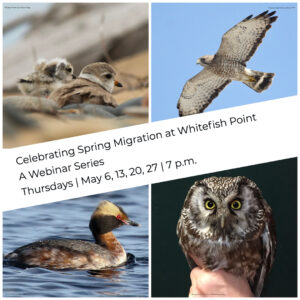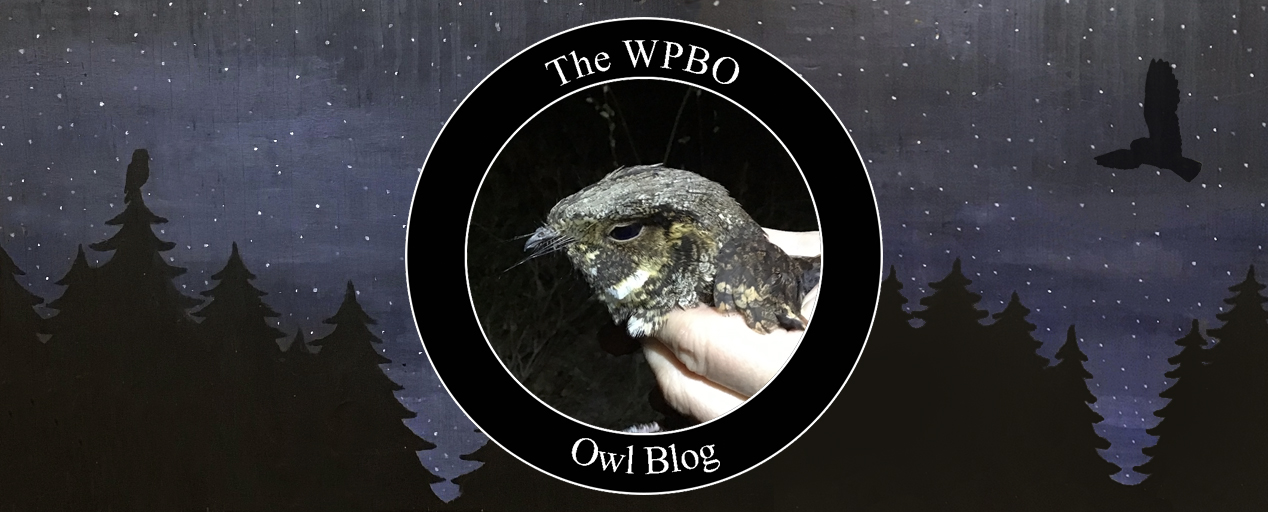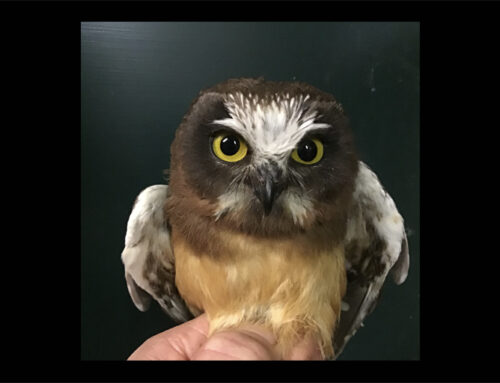We experienced a transition in the owl migration this past week. With the exception of a few bad weather nights that predictably shut down the owl migration last month, we banded Long-eared Owl (LEOW) every night from April 1 through May 16. Despite good conditions, we have not banded any LEOW these last two nights. The ridiculous thing about this is that prior to the season, I predicted we would band 387 LEOW and Nova predicted that we’d band 465. We even wrote it on the board in the lab so we wouldn’t forget. Nova’s prediction was quite bold, as we have never banded that many LEOW in a season. How many LEOW have we banded this season? To date, we have banded 463. We’re hoping that a few stragglers will show up, but even if they don’t, Nova’s prediction has already proven to be an amazingly good one. Mine? Not so much.
As if on cue, we started seeing the late-season spike in Northern Saw-whet Owl migration just as the long-eared numbers began to drop. We don’t know why late May regularly produces this spike in saw-whet numbers. Are these failed breeders? Are they southern breeders that have already fledged young and are now moving north, as some diurnal raptor populations do? We simply do not know, but we are thankful that it has begun. To date, we have banded 1,258 owls and recaptured 62 previously banded owls. Now, if the weather would just provide us with our first night off in over three weeks.
In addition to the owls, we caught the first Eastern Whip-poor-will of the season this week. We band a few most springs, and it is incredible to see these birds up close. One of the most amazing things to see is the size of their mouths. For a bird that only shows a small narrow bill, their mouths are actually shockingly large. Nightjars regularly make vocalizations when they are in hand. It starts with a low gurgling, then turns into a hiss as they fully open their mouths. The first time I saw this was on a Common Poorwill when I was banding Flammulated Owls in Nevada. My jaw dropped when I saw its mouth. The large mouth of a nightjar is the last thing many insects see as they are snatched out of the air. We cannot help but think of the Muppets when we see their heads seemingly open up in half when they open their mouths up wide. The below photo shows the open mouth on a Chuck-will’s-widow we banded here in 2010 on the left and this week’s whip-poor-will on the right.

The open mouth of a Chuck-will’s-widow (left) and the small visible bill of an Eastern Whip-poor-will (right).
2021 Spring Owl Banders
Chris Neri & Nova Mackentley
You can read Chris and Nova’s weekly blog post and follow WPBO’s social media (Facebook, Instagram, and Twitter) for owl banding highlights this season.
Owl Banding Presentations — We apologize, but live education demonstrations of our owl banding program will not be offered in 2021 due to COVID-related risks and restrictions.
If you visit WPBO, please practice social distancing while doing so. Although not required, we encourage you to wear masks if you are in close proximity to other people, even if outdoors. You may read the full 2021 COVID-19 Updates for Michigan Audubon and Whitefish Point Bird Observatory here.

Celebrating Spring Migration at Whitefish Point — A Webinar Series
Owls of Whitefish Point
May 6 | 7 p.m.
Would you like to learn more about the owls at Whitefish Point? Join us for a presentation by Owl Banders Chris Neri and Nova Mackentley, who introduce the ten species of owls seen at the Point, explain the banding process, and review data collected over the years. Their wealth of knowledge about the owl banding history at WPBO is enlightening and inspirational! Please note that Chris and Nova’s presentation is prerecorded (they are in the middle of their banding season, after all!). We will have other avian experts and WPBO veterans on hand to answer your questions about these wondrous raptors and how banding supports avian research efforts.
This event is the first in a four-part series of free webinars celebrating spring migration at the Point and highlighting WPBO research programs.




